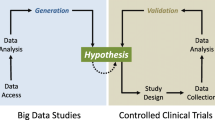Abstract
Within a generation, empirical researchers have experienced unprecedented increases in the availability of data. ‘Big data’ has arrived with considerable hype and a sense that these are dramatic shifts in the research environment that have wide-reaching implications across many disciplines. There is no doubt that the analysis of new and varied sources of data currently available to researchers in health have the potential to better measure, monitor and describe health outcomes of patients and to uncover interesting patterns in how patients respond to treatments and interact with the health system. What is less clear is whether answers are readily available to more nuanced and substantive research questions. Here, the data-rich environment needs to be complemented by considerable research effort developing novel research designs and generating new and improved methods of analysis. Importantly, this will require researchers to be able to combine data from multiple sources and to be pro-active in data collection.
Similar content being viewed by others
References
Kalil T. Big data is a big deal. Washington, DC: The White House; 2012. Available from: http://www.whitehouse.gov/blog/2012/03/29/big-data-big-deal. Accessed 10 Oct 2016.
Anderson C. The end of theory: the data deluge makes the scientific method obsolete. Wired. Boone, IA; 2008. Available from: http://www.wired.com/2008/06/pb-theory/. Accessed 10 Oct 2016.
Griliches Z. Economic data issues. In: Griliches Z, Intriligator MD, editors. Handbook of econometrics. Amsterdam: North Holland; 1986.
Coale AJ, Stephan FF. The case of the Indians and the teen-age widows. J Am Stat Assoc. 1962;57(298):338–47.
Rosenbaum L. What big data can’t tell us about healthcare. The New Yorker, 2014. Available from: http://www.newyorker.com/business/currency/what-big-data-cant-tell-us-about-health-care. Accessed 10 Oct 2016.
Ellis RP, Fiebig DG, Johar M, Jones G, Savage E. Explaining health care expenditure: large-sample evidence using linked survey and health administrative data. Health Econ. 2013;22:1093–110.
Doiron D, Fiebig DG, Suziedelyte A. Hips and hearts: the variation in incentive effects of insurance across hospital procedures. J Health Econ. 2014;37:81–97.
Suziedelyte A. How does searching for health information on the Internet affect individuals’ demand for health care services? Soc Sci Med. 2012;75:1828–35.
Levitt SD, List JA, Neckermann S, Nelson D. Quantity discounts on a virtual good: the results of a massive pricing experiment at King Digital Entertainment. Proc Natl Acad Sci. 2016;113(27):7323–8.
Currie J. ‘Big data’ versus ‘big brother’: on the appropriate use of large-scale data collections in paediatrics. Pediatrics. 2015;131:S127–32.
Keller SA, Shipp S, Schroeder A. Does big data change the privacy landscape? A review of the issues. Ann Rev Stat Appl. 2016;3:161–80.
Dempsey W, Liao P, Klasnja P, Nahum-Shani I, Murphy SA. Randomised trials for the Fitbit generation. Significance. 2015;12(6):20–3.
Coons SJ, Eremenco S, Lundy JJ, O’Donohoe P, O’Gorman H, Malizia W. Capturing patient-reported outcome (PRO) data electronically: the past, present, and promise of ePRO measurement in clinical trials. Patient. 2015;8:301–9.
Koulayev S, Simeonova E, Skipper N. Can physicians affect patient adherence with medication. Health Econ. doi:10.1002/hec.3357. [Epub 16 June 2016].
Ellis RP, Zhu W. Health plan type variations in spells of health care treatment. Am J Health Econ. 2016. http://www.mitpressjournals.org/page/journal/forthcoming.jsp?journalCode=ajhe. (forthcoming).
Finkelstein A, Taubman S, Wright B, Bernstein M, Gruber J, Newhouse JP, Allen H, Baicker K, Oregon Health Study Group. The Oregon health insurance experiment: evidence from the first year. Q J Econ. 2012;127(3):1057–106.
Baicker K, Taubman S, Allen H, Bernstein M, Gruber J, Newhouse JP, Schneider E, Wright B, Zaslavsky A, Finkelstein A, Oregon Health Study Group. The Oregon experiment: effects of Medicaid on clinical outcomes. N Engl J Med. 2013;368(18):1713–22.
Nordin M, Dackehag M, Gerdtham UG. Socioeconomic inequalities in drug utilization for Sweden: evidence for linked survey and register data. Soc Sci Med. 2013;77:106–17.
Metherell M. It’s time to rethink role of doctors. The Sydney Morning Herald. 2008. Available from: http://www.smh.com.au/news/national/its-time-to-rethink-role-of-doctors/2008/04/20/1208629731343.html. Accessed 10 Oct 2016.
Kesternich I, Heiss F, McFadden D, Winter J. Suit the action to the word, the word to the action: hypothetical choices and real decisions in Medicare Part D. J Health Econ. 2013;32:1313–24.
Fiebig DG, Knox SA, Viney R, Haas M, Street D. Preferences for new and existing contraception products. Health Econ. 2011;20(S1):35–52.
King MT, Hall JP, Lancsar EJ, Fiebig DG, Hossain I, Louviere JJ, Reddell HK, Jenkins CR. Patient preferences for managing asthma: results from a discrete choice experiment. Health Econ. 2007;16:703–17.
Benning TM, Kimman ML, Dirksen CD, Boersma LJ, Dellaert BGC. Combining individual-level discrete choice experiment estimates and costs to inform health care management decisions about customized care: the case of follow-up strategies after breast cancer treatment. Value Health. 2012;15:680–9.
Joyce C, Scott A, Jeon S, Humphreys J, Kalb G, Witt J, Leahy A. The ‘Medicine in Australia: Balancing Employment and Life (MABEL)’ longitudinal survey: protocol and baseline data for a prospective cohort study of Australian doctors’ workforce participation. BMC Health Serv Res. 2010;10:10–50.
Hastie T, Tibshirani R, Friedman J. The elements of statistical learning: data mining, inference, and prediction. 2nd ed. New York: Springer; 2011.
Varian HR. Causal inference in economics and marketing. Proc Natl Acad Sci. 2016;113(27):7310–5.
Kleinberg J, Ludwig J, Mullainathan S, Obermeyer Z. Prediction policy problems. Am Econ Rev. 2015;105(5):491–5.
Manyika J, Chui M, Brown B, Bughin J, Dobbs RC, Roxburgh C, Hung A. Big data: the next frontier for innovation, competition, and productivity. McKinsey Global Institute. 2011. Available from: http://www.mckinsey.com/insights/business_technology/big_data_the_next_frontier_for_innovation. Accessed 10 Oct 2016.
Lohr S. For today’s graduate, just one word: Statistics. The New York Times. 2009. Available from: http://www.nytimes.com/2009/08/06/technology/06stats.html?_r=1. Accessed 10 Oct 2016.
Author information
Authors and Affiliations
Corresponding author
Ethics declarations
Acknowledgments
The author has benefited from discussions with Denise Doiron and Helen Godfrey and from the comments of two anonymous referees and the journal editor, Chris Carswell. The support of the UNSW Business School through the Strategy 2020 Network on “Big Data Modelling for Policy Evaluation” is gratefully acknowledged.
Conflict of interest
The author has no conflicts of interest.
Rights and permissions
About this article
Cite this article
Fiebig, D.G. Big Data: Will It Improve Patient-Centered Care?. Patient 10, 133–139 (2017). https://doi.org/10.1007/s40271-016-0201-0
Published:
Issue Date:
DOI: https://doi.org/10.1007/s40271-016-0201-0




